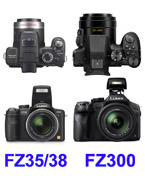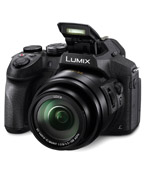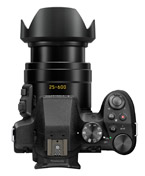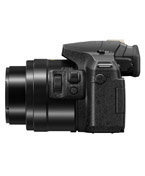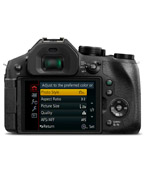Exposure features
Mode Dial: selecting the recording mode
The most commonly used “modes” refer to exposure control: they are the modes iA, P, A, S and M.
Mode iA
Intelligent Auto. This mode is meant to automate everything: lens aperture, shutter speed, ISO sensitivity, white balance, flash with red-eye correction (if it has been popped up), lens stabilizer and even more features. Most important is the Scene Detection: when the camera detects a particular shooting situation, a specific Scene icon appears on the top left corner (instead of the “iA” icon) and the camera is adjusted accordingly.
Also, with both Modes iA/iA+, whatever assignment you made to the Fn2 button is disabled and normally the Rear Dial is disabled as well. Now by pressing this button you enable the Rear Dial to change the pairing of aperture vs speed in order to control the depth of field.
Mode iA+
Intelligent Auto Plus. With the Mode Dial in “iA”, press Menu and a first left icon “iA+” shows on top, allowing to switch between “iA” and “iA+”. Or else simply touch the “iA” icon on the top left corner of the screen. Mode iA+ is like iA but less automated, allowing the following user tweaks (disabled in Mode iA):
- Press the WB button and rotate the Rear Dial to shift colour towards either Yellow or Blue.
- Press the Fn1+/- button to brighten or darken the exposure (see Exposure Compensation below).
Modes P | A | S | M
Unlike iA, these modes affect only the main exposure controls: lens aperture and shutter speed. Before taking the picture, the user has to set separately other exposure features (such as ISO sensitivity, white balance and flash mode), setting each one to either Auto or different fixed settings. Let us now see how each one of the Modes P | A | S | M controls the lens aperture and shutter speed.
Mode P
Programme AE (Auto Exposure). It fully automates both aperture and speed, changing both together according to measured subject light. For brighter subjects the camera gradually closes the aperture and sets higher speeds, reaching the closest 1:8.0 only for very high speeds at or above 1/1000". Viceversa, for dark subjects the camera gradually opens the aperture and sets slower speeds. Once the full aperture 1:2.8 has been reached with speed 1/100", if the subject is still too dark for this exposure, the “programme” keeps the 1:2.8 aperture while decreasing shutter speed (i.e. increasing exposure time). If the user has set ISO to Auto, the camera will simultaneously increase exposure time and ISO, the latter faster to prevent too slow a speed (for every 1/3 EV exposure is increased, ISO is increased by 1 EV). The user's “ISO Limit” becomes crucial to avoid excessive noise, especially if tripod or other support is available to avoid a blurry picture due to the slow speed. As in Mode iA, the Rear Dial (but now without any need to enable it) will produce a “programme Shift”, allowing to change the pairing of aperture vs speed in order to control the depth of field.
Mode A
Aperture-priority AE. The user selects the aperture between 1:2.8 and 1:8.0 by rotating the Rear Dial. The camera decides the necessary shutter speed for a correct exposure of the picture. Needless to say, this is the best mode to control the depth of field. When the subject is too dark, if the user has set ISO to Auto, the camera simultaneously decreases shutter speed (i.e. increases exposure time) and increases the ISO sensitivity, thus behaving similarly to Mode P (although now with the user-selected aperture).
Mode S
Shutter-priority AE. The user selects any shutter speed by rotating the Real Dial. The camera decides the necessary aperture for a correct exposure of the picture. When the subject is too dark for 1:2.8 at the selected speed, if the user has set ISO to Auto, the camera will keep the aperture 1:2.8 and increase ISO sensitivity as needed. The fastest speed is 1/4000" for the Mechanical shutter and 1/16000" for the Electronic shutter. If you (like me) set the Shutter Type to Auto (whereby the camera will mostly use the Mechanical shutter, and set the Electronic one only for for either very fast speeds or when you select "Silent mode"), the shutter will change over to Electronic at any speed faster than 1/2000", not 1/4000" (who knows why!). The only way to overcome this quirk if you really wish to have the Mechanical Shutter at 1/4000" is to set the Shutter Type to Mechanical.
Mode M
Manual Exposure. The user selects both aperture and speed (using for either the Rear Dial, switching aperture vs speed by just pressing F1). What then happens depends on the ISO setting:
- Fixed ISO: A display on screen shows whether the picture is underexposed, well exposed or overexposed. The user may wish to change aperture, speed or both to achieve correct exposure, or else none to keep the picture under/over-exposed.
- Auto ISO: Similar, but if the camera finds that the picture will be underexposed, automatically sets ISO to a higher value: only when ISO is not enough it shows the picture as underexposed.
One Push AE
In any of the Modes P, A, S or M it may happen that, either because an aperture or ISO limit has been reached, or because of a fully Manual setting, the exposure is incorrect. At this point the user may wish that, without changing the Mode, the camera automatically changes either aperture or speed in order to set a correct exposure This function can be custom-assigned to any button (I use for this the “soft-button” Fn8).
Exposure Compensation
This feature, common to most digital cameras, is particularly handy on the FZ300, where it is available for all the Modes. Just press the Fn1+/- button, and the Rear Dial (which otherwise changes either speed or aperture) makes the exposition either brighter or darker: this is shown onscreen not only in the brightening/darkening of the image, but also in small marks under the -3 . . 0 . .+3 scale. Another effect of the Fn1+/- button is that the Side Dial (normally manual-focusing) regulates the flash maximum power: this is shown onscreen with a either a “+” or a “-” after the flash symbol. As I mentioned in our External Flash webpage, I have been able to take good pictures 30 ft away with ISO 800.
Attention! These exposure-compensation and flash-power settings are memorised forever, and their small onscreen marks are easy to get unnoticed when you take the camera again later. It is a pity that no button-assignable functionality is available to reset these compensations to zero.
Auto ISO with ISO Limit and iISO
These distinct functionalities are most useful. They are controlled by pressing the ISO button and then rotating the Rear Dial (you can also select a fixed ISO value).
- AUTO. If this is the ISO setting selected, after pressing the shutter button halfway, together with the focus marks and sound, you see onscreen the ISO value the camera has selected for you.
- ISO Limit. If you set ISO to AUTO, the ISO Limit is the maximum ISO the camera will set automatically. Of course, you can set manually any ISO value you wish. Or else, you can change the ISO Limit, while in the ISO onscreen dialog, using the Side Dial.
- iISO. This is an alternative to Auto ISO, meant for a more restricted use: it is only recommended for sports, babies and animals pictures, it is incompatible with some other features (such as "P" mode), and unfortunately the ISO value is not shown onscreen, probably because it can change very quickly with the subject's movement.
White Balance Measurement
The Panasonic Manuals call this functionality “Setting the White Balance manually”, but actually you select one of up to 4 possible “memories”, you then point the camera at something you know should look white or clear gray (i.e. completely colourless or desaturated), and you press the “up” button (the one labelled “ISO”): the camera accurately measures the real-life white balance and stores it as selected. After this, and as long as light conditions stay unchanged (for example in different rooms of a museum) the pictures come out with a perfect “colour temperature”, which very often implies an excellent colour balance. The only annoyance is that, obviously due to a software bug, when storing the measured white balance the camera makes a shutter noise: do not worry, no picture has been taken.
Bracketing and HDR
When the subject has extreme light contrast, whereby there will be large parts of it very dark with no detail, and other very bright or even white, a later computer process may not be able to resolve the issue, because actually some information has not been captured. There are two solutions:
- Auto Bracket. This is available as one of the “Drive Modes”: when the user press the shutter the camera typically takes 3 pictures in fast sequence: dark, medium and bright. Later a computer photo editor allows to combine them, either manually or with some specific plugins, and achieve an ideal exposure and detail of the whole picture. Unfortunately this sometimes fails to work properly: the result may be wrongly exposed, or else oversaturated.
- HDR. On the FZ300, a higher probability of success—with much less work—is to let the camera to do it all, by just setting HDR to On (I have included this option in my Q.MENU customisation).
